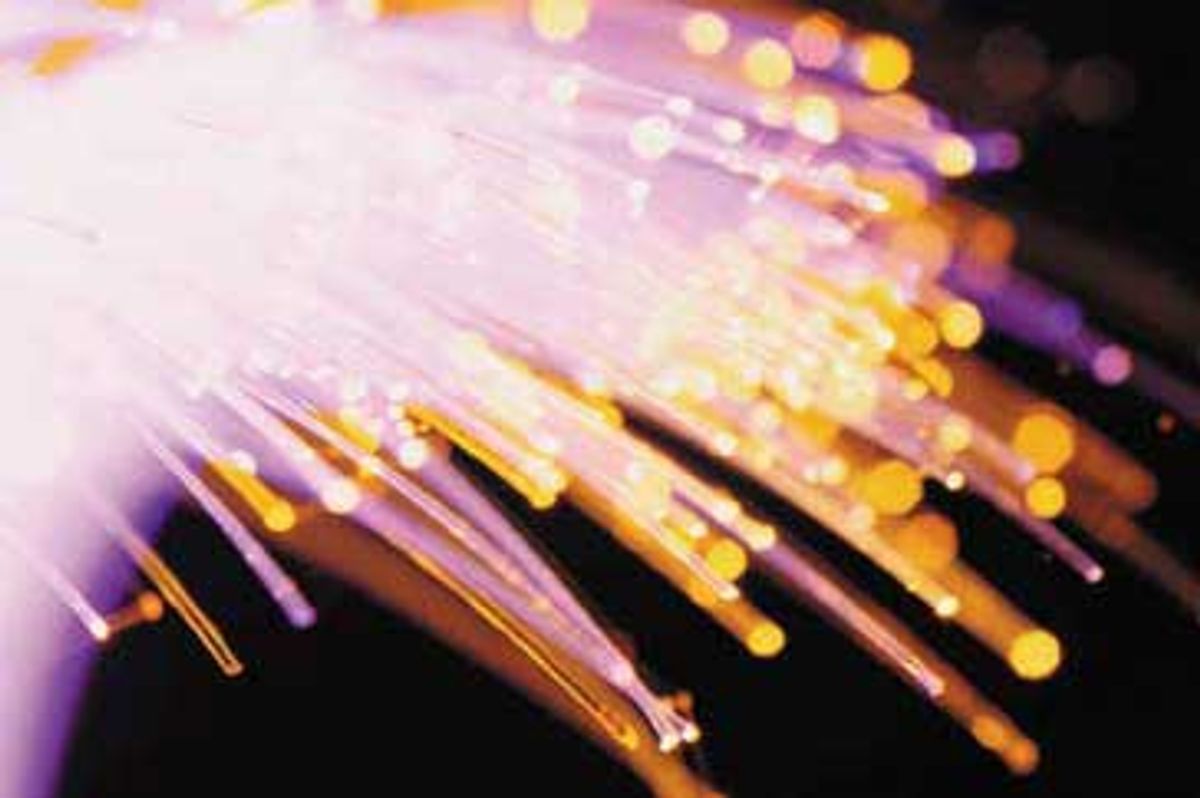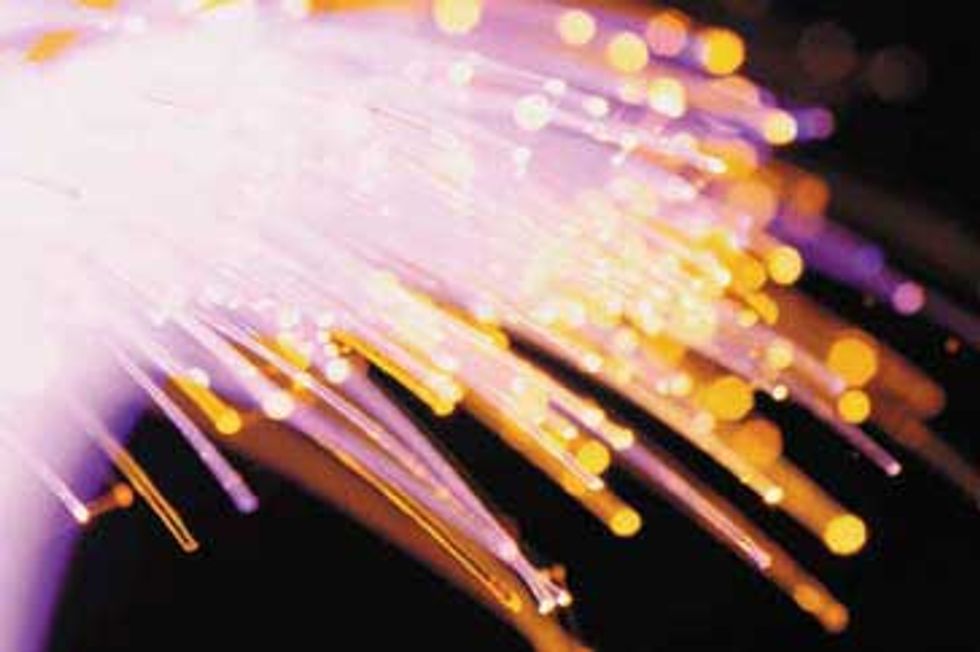Optical Nets Brace for Even Heavier Traffic
While optical fibers are clearly the way to carry long-haul traffic, how best to repave the last mile is harder to figure--it may need optics, minus the fiber

This is part of IEEE Spectrum's special report: Always On: Living in a Networked World.
A couple of decades ago, it was anything ending in -tron or -tronics. More recently, the dot-coms had their 15 minutes in the limelight. Today, it's opto-. Tack the prefix onto a company name and the venture capitalists come running, checkbooks at the ready. Newsstands are awash in business magazines explaining that optical technology makes possible communication at the speed of light--as if the microwave radio circuits of yesteryear propagated their signals at some lesser velocity.
Why all the interest in photonics? What is suddenly so exciting about optical telecommunications technology? It has, after all, been carrying most of the world's long-distance communications for more than a decade. The answer, in two words: the Internet.
Thanks to that network of networks, backbone traffic has been increasing at a compound annual growth rate of more than 100 percent for several years--since 1995 in the United States and for perhaps two years less in Europe, according to K.C. Szelag, marketing vice president for Lucent Technologies' Optical Networking Group in Holmdel, N.J. Before the Internet took off, she estimates, backbone traffic grew at a compound rate of about 6-10 percent.
The owners of the backbone infrastructure, which is almost entirely fiber-based, are therefore eagerly embracing technologies that add to the capacity of fiber-optic systems without adding mountains of new optical cable. The financial community, in turn, has subjected to intense scrutiny the companies that make possible that capacity increase--companies like Alcatel, Ciena, Corning, Fujitsu, Lucent, and Nortel.
Of course, having sufficient backbone capacity doesn't mean that everyone gets a high-speed connection to the Internet. It simply means that huge quantities of data can be transported between and among certain locations.
Then there is that pesky problem of the last mile--the connection between the service provider and the end-user. Some people believe that optical fiber can do for the last mile what it has done for the backbone, but the economics of that approach are open to question [see "Let's Not Go Broke Repaving the Last Mile,"]. An alternative approach to the last mile is fiberless optics--transmitting unguided laser beams through the air. Yet to be commercially deployed, the technology promises both high transmission speeds and fast provisioning (commspeak for installation).
Sharing is good
The main approach to increasing the capacity of optical fibers is wavelength-division multiplexing (WDM), the optical equivalent of frequency-division multiplexing, which shares the air waves among multiple radio and TV stations. With WDM, instead of sending just one modulated light wave down each fiber strand, many are sent, each at a different wavelength, so they can be separated at the far end of the cable.
What makes the technology exciting just now is the performance it is achieving. The earliest WDM systems multiplexed just two wavelengths. Today, the most advanced commercial products handle 160 wavelengths. Dense WDM (DWDM) systems capable of combining and then separating 320 wavelengths are only about a year away.
Multiplexing a rising flood of wavelengths onto a single fiber is a far from simple task. For one thing, as the difference between wavelengths gets smaller, the need for wavelength stability becomes greater, lest the optical carriers drift into each other's turf. So a lot hinges on how difficult (read: expensive) it will be to make lasers of appropriate quality.
Another issue concerns the realities of operating a DWDM network. Every physical interface board in a wavelength-division multiplexer contains a laser of a wavelength different from all the others. Therefore, a year or so from now, unless a better way is adopted, some network operators will have to maintain a stock of 320 different kinds of boards--one for every wavelength--just so as to have a replacement on hand if a board should fail. A large network operations center might need several of each wavelength. DWDM system lasers can cost thousands of dollars. You do the math.
Fortunately, a solution does exist: the tunable laser. Instead of carrying an inventory of thousands of single-wavelength boards, a system operator can get the same system reliability by stocking only a dozen or so tunable ones, at a cost savings measured in the millions of dollars. When a board must be replaced, a technician can grab any of the tunable-laser boards, adjust its wavelength, and plug it in.
Faster, faster
Another approach to increasing the capacity of optical fibers is simply to raise the bit-rate of each time-division multiplexed data stream--the rate at which each laser is modulated. The current state of the art is 10 Gb/s, as represented by what is called synchronous optical network (Sonet) OC-192 technology in North America and synchronous digital hierarchy (SDH) STM-64 technology in Europe. Successive generations of Sonet/SDH equipment generally grow in speed by multiples of four, so the next generation will run at 40 Gb/s.
But how much farther can these speeds be pushed? It is not obvious that electronic circuitry capable of multiplexing together a single 160-Gb/s data stream (the next logical step after 40 Gb/s) can be built at reasonable cost. The solution, most experts seem to agree, is not to try to do the job electronically, but rather to do the time-division multiplexing optically--that is, create lower-speed signals electronically, modulate them onto light beams, and then combine the light beams. Experiments along these lines are under way in many laboratories around the world and should yield commercially deployable results within a few years.
But there's another problem. Most of the fiber currently in place around the world would have trouble carrying these very fast signals for long distances in a DWDM system because of a combination of nonlinearities and dispersion. Between them, these impairments can lead to cross-talk among the different wavelengths, interference between consecutive pulses on any single wavelength, and a degradation in the overall signal-to-noise ratio.
Solutions to this problem exist in the form of advanced optical fibers, like Corning's LEAF (large effective aperture fiber) and Lucent's TrueWave, but unfortunately, 95 percent of currently installed cable is not of that type. Large service providers will, in time, replace their older cables with advanced ones. But with profits in the long-distance business down in the cellar, they are not exactly rushing to do so.
Just as some medical mavens argue that dietary fiber is the cure for all failings of the flesh, there are silica savants who hold that fiber is the cure for all communications complaints. Run fiber all the way to the end-user, and our problems are over, they say. This all sounds very well, but it ignores three important facts: installing optical cabling is expensive, the terminating equipment for optical cabling is expensive, and optical fibers do not conduct electricity and therefore cannot themselves deliver the power needed for operating the terminating equipment in a power outage.
In the long-haul plant, costs are apportioned among a great many users. At the local-loop level, all of the costs must be justified on the basis of the end-user being served. An optical network unit--the box that converts between optical and electrical signals--can cost several thousand dollars. Who will pay for it?
Telephone companies have traditionally maintained large batteries for powering themselves and their customers during blackouts. If optical cabling is used for last-mile connections, should copper power lines be bundled into them? That would raise costs and saddle communications service providers with the job of providing the not inconsiderable amount of power needed by an optical network unit. If it is not done, individuals might lose their telephone lifelines every time there is a power outage.
Systems for handling 320 different wavelengths are only a year away
For the next few years, at least, what makes the most sense are hybrid fiber systems, in which fiber extends into neighborhoods, and twisted-pair wiring or coaxial cable takes it from there to the end-users. Digital subscriber-line (DSL) technology can then boost the capacity of the twisted pairs to a surprising degree. The speed of a DSL varies inversely with the length of the line. If it is short, as in a hybrid arrangement, transmission speeds of 50 Mb/s are not unreasonable [see the DSL speed table on the back of the foldout].
Through the air
One really innovative way to cut the cost of fiber is not to install it at all. Instead, beam the optical waves through the air. With the right infrastructure in place, subscribers to a fiberless optical service provider can simply aim an optical terminal out a window at the service provider's hub and be connected to the Internet.
That eliminates not only the time and expense of installing fiber, but also the need for a rooftop installation and the negotiations entailed therein. Of course, it will only work for subscribers with a direct line of sight to a service provider's site, so figuring out where to locate the network hubs will be a critical part of deploying such systems.
The technology is being pioneered by Terabeam, a Seattle-based company that expects to roll out its first system within the next 60-90 days, and to be operating in five more cities by the end of this year. According to company spokesman Lou Gellos, Terabeam will be able to serve most of Seattle's downtown core from just 11 carefully chosen sites. It will offer two kinds of service: Internet access and connectivity between local-area networks (LANs). Subscribers to Terabeam's services will be able to communicate at rates as high as 1 Gb/s, Gellos said, but he expects that most will opt for lower rates of 5, 10, or 100 Mb/s.
Interestingly, because the free-space optical links are fairly short—no more than a few hundred meters—fog, snow, and rain are not serious impediments to optical transmission, and laser output powers can be kept within recognized safety limits. The technology can deliver dedicated (not shared) links with capacities of up to 1 Gb/s, and it can be provisioned fairly quickly, within a matter of a few weeks.
If it works as hoped, fiberless optical networking may solve the last-mile problem for a great many users. Imagine an interexchange carrier's point of presence in a metropolitan area radiating optical fibers to a cluster of optical hubs, and all last-mile connections radiating from those hubs. All traffic will, of course, be carried via the Internet protocol, and there will be bandwidth and access for all.
To Probe Further
The 2001 Optical Fiber Communication Conference (OFC), to be held in Anaheim, Calif., 17-22 March, will be a good place to learn about optical communications in a hurry. For information, and to register, visit https://www.osa.org/mtg_conf/OFC/.
For a comprehensive, easy-to-read introduction to all aspects of optical communication, see Introduction to DWDM Technology by Stamatios V. Kartalopoulos (IEEE Press, New York, 2000).
